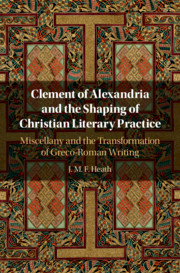 Clement of Alexandria and the Shaping of Christian Literary Practice
Clement of Alexandria and the Shaping of Christian Literary Practice The Making of a Christian Miscellanist
Published online by Cambridge University Press: 16 December 2020
Clement’s theme of hiddenness is connected with mystery imagery, which was a widespread topos for imagining many kinds of ‘initiation’, not only in religion and philosophy but also in more text-based arts of reading, writing and rhetoric. Clement worked creatively with this imagery to compose a mystagogical curriculum in hidden listening, where miscellanism became important at the higher stages. He shapes his three works sequentially as a programme that trains Christians to listen in a hidden way, and ultimately equips them to miscellanise better than any heretics. In the Stromateis, he engages in contemporary controversies that have sparked debate about how to miscellanise well. For Clement, miscellanism will ultimately be judged by sensitivity to the nous or telos of Scripture; this depends on a person's doctrine of God, but also on her own ethical behaviour, which conditions her possibility of knowing God and on her prayerfulness and application, for only in love and gratitude towards the Creator and in the labour of gathering passages from Scripture, is it possible truly to miscellanise well, learning the mysteries from God himself.
To save this book to your Kindle, first ensure [email protected] is added to your Approved Personal Document E-mail List under your Personal Document Settings on the Manage Your Content and Devices page of your Amazon account. Then enter the ‘name’ part of your Kindle email address below. Find out more about saving to your Kindle.
Note you can select to save to either the @free.kindle.com or @kindle.com variations. ‘@free.kindle.com’ emails are free but can only be saved to your device when it is connected to wi-fi. ‘@kindle.com’ emails can be delivered even when you are not connected to wi-fi, but note that service fees apply.
Find out more about the Kindle Personal Document Service.
To save content items to your account, please confirm that you agree to abide by our usage policies. If this is the first time you use this feature, you will be asked to authorise Cambridge Core to connect with your account. Find out more about saving content to Dropbox.
To save content items to your account, please confirm that you agree to abide by our usage policies. If this is the first time you use this feature, you will be asked to authorise Cambridge Core to connect with your account. Find out more about saving content to Google Drive.